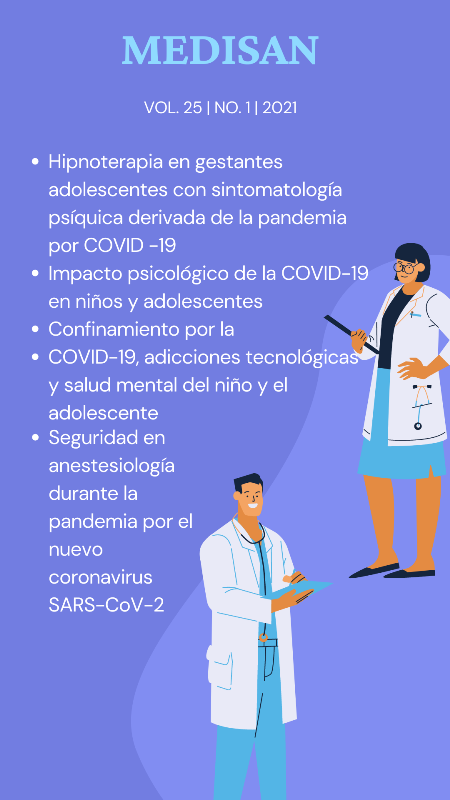Value from the tibial-tuberosity to trochlear groove distance in the patellofemoral instability
Keywords:
patellofemoral articulation, patellofemoral instability, computerized axial tomography, magnetic resonance imaging.Abstract
The patellofemoral instability is an entity that mainly affects adolescents and young adults. In its diagnosis clinical and imaging elements are considered, especially to measure the tibial-tuberosity to trochlear groove distance that allows the selection of the surgical technique in each patient, in specific the transfer of the tibial-tuberosity. In this work some aspects of interest on the topic are shortly exposed: the imaging methods used in these patients (simple x-rays, computerized axial tomography, magnetic resonance imaging) and the reference values considered as normal; it is also described step by step how to measure the tibial-tuberosity to trochlear groove distance.
Downloads
References
2. Christensen TC, Sanders TL, Pareek A, Mohan R, Dahm DL, Krych AJ. Risk factors and time to recurrent ipsilateral and contralateral patellar dislocations. Am J Sports Med. 2017;45(9):2105-10.
3. Farr J. Editorial commentary: what is the optimal management of first and recurrent
patellar instability? Patellofemoral instability management continues to evolve. Arthroscopy. 2018;34(11):3094-7.
4. Fathalla I, Holton J, Ashraf T. Examination under anesthesia in patients with recurrent patellar dislocation: prognostic study. J Knee Surg. 2019;32(4):361-5.
5. Ye Q, Yu T, Wu Y, Ding X, Gong X. Patellar instability: the reliability of magnetic resonance imaging measurement parameters. BMC Musculoskelet Disord. 2019 [citado 13/02/2020];20(1):317. Disponible en: https://www.ncbi.nlm.nih.gov/pmc/articles/PMC6612413/pdf/12891_2019_Article_2697.pdf
6. Tompkins MA, Rohr SR, Agel J, Arendt EA. Anatomic patellar instability risk factors in primary lateral patellar dislocations do not predict injury patterns: an MRI-based study. Knee Surg Sports Traumatol Arthrosc. 2018;26(3):677-84.
7. Ferlic PW, Runer A, Dirisamer F, Balcarek P, Giesinger J, Biedermann R, et al. The use of tibial tuberosity-trochlear groove indices based on joint size in lower limb evaluation. Int Orthop. 2018;42(5):995-1000.
8. Hochreiter B, Hess S, Moser L, Hirschmann MT, Amsler F, Behrend H. Healthy knees have a highly variable patellofemoral alignment: a systematic review. Knee Surg Sports Traumatol Arthrosc. 2020;28(2):398-406.
9. Tan SHS, Ibrahim MM, Lee ZJ, Chee YKM, Hui JH. Patellar tracking should be taken into account when measuring radiographic parameters for recurrent patellar instability. Knee Surg Sports Traumatol Arthrosc. 2018;26(12):35-93.
10. Dewan V, Webb MSL, Prakash D, Malik A, Gella S, Kipps C. When does the patella dislocate? A systematic review of biomechanical & kinematic studies. J Orthop. 2019;20:70-7.
11. Bartsch A, Lubberts B, Mumme M, Egloff C, Pagenstert G. Does patella alta lead to worse clinical outcome in patients who undergo isolated medial patellofemoral ligament reconstruction? A systematic review. Arch Orthop Trauma Surg. 2018;138(11):1563-73.
12. Hevesi M, Heidenreich MJ, Camp CL, Hewett TE, Stuart MJ, Dahm DL, et al. The recurrent instability of the patella score: a statistically based model for prediction of long-term recurrence risk after first-time dislocation. Arthroscopy. 2019;35(2):537-43.
13. Hernigou J, Chahidi E, Bouaboula M, Moest E, Callewier A, Kyriakydis T, et al. Knee size chart nomogram for evaluation of tibial tuberosity-trochlear Groove distance in knees with or without history of patellofemoral instability. Int Orthop. 2018;42(12):2797-806.
14. Xiong R, Chen C, Yin L, Gong X, Luo J, Wang F, et al. How do axial scan orientation deviations affect the measurements of knee anatomical parameters associated with patellofemoral instability? A simulated computed tomography study. J Knee Surg. 2018;31(5):425-32.
15. DeJour D, Saggin PRF, Kuhn VC. Disorders of the Patellofemoral Joint. En: Scott WN. Insall & Scott Surgery of the Knee. 6 ed. Philadelphia: Elsevier; 2018.p.843-84.
16. Arendt EA. Editorial Commentary: reducing the Tibial Tuberosity-Trochlear Groove distance in patella stabilization procedure. Too much of a (good) thing? Arthroscopy. 2018;34(8):2427-8.
17. Franciozi CE, Ambra LF, Albertoni LJB, Debieux P, Granata GSM, Kubota MS, et al. Anteromedial tibial tubercle osteotomy improves results of medial patellofemoral ligament reconstruction for recurrent patellar instability in patients with Tibial Tuberosity-Trochlear Groove distance of 17 to 20 mm. Arthroscopy. 2019;35(2):566-74.
18. Hinckel BB, Gobbi RG, Kihara Filho EN, Demange MK, Pécora JR, Rodrigues MB, et al. Why are bone and soft tissue measurements of the TT-TG distance on MRI different in patients with patellar instability? Knee Surg Sports Traumatol Arthrosc. 2017;25(10):3053-60.
19. Brady JM, Rosencrans AS, Shubin Stein BE. Use of TT-PCL versus TT-TG. Curr Rev Musculoskelet Med. 2018;11(2):261-5.
20. Cao P, Niu Y, Liu C, Wang X, Duan G, Mu Q, et al. Ratio of the tibial tuberosity-trochlear groove distance to the tibial maximal mediolateral axis: a more reliable and standardized way to measure the tibial tuberosity-trochlear groove distance. Knee. 2018; 25(1):59-65.
Published
How to Cite
Issue
Section
License
All the articles can be downloaded or read for free. The journal does not charge any amount of money to the authors for the reception, edition or the publication of the articles, making the whole process completely free. Medisan has no embargo period and it is published under the license of Creative Commons, International Non Commercial Recognition 4.0, which authorizes the copy, reproduction and the total or partial distribution of the articles in any format or platform, with the conditions of citing the source of information and not to be used for profitable purposes.





